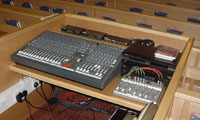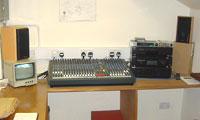|
Recording - One Desk or Two?
Recording normally takes second place to the P.A. system,
and in some instances, the investment is limited to adding
a cassette deck to the system. This may be perfectly adequate
if the P.A. is a simple system, used primarily for speech
amplification (perhaps using just a combined mixer/amplifier
with a small number of channels). When music is involved,
systems tend to get bigger, and the problems associated with
making good quality recordings increase.
A good mix for P.A. is rarely a good mix
for recording. Some louder acoustic instruments do not need
to be amplified - but if they are not, they are missing (or
at low level) in recordings. The congregation do not need
to be amplified, but again, are needed in the recording. In
large churches, a lead instrument (often piano) or worship
leader, may need to be amplified over the level of the congregational
singing, but if so, they will be overbearing in the recording.
The usual solution is to use a conventional
P.A. desk in a slightly unusual mode of operation. Recordings
are taken from the main mix outputs, and the P.A. system is
fed from an auxiliary output. This means that certain mics
may be recorded but not amplified, while others are amplified
but not recorded. Many of course, will contribute to both
the amplified sound, and the recording. For the vast majority
of churches, this will be quite adequate - good P.A. control,
and reasonable recordings. This system has the advantage of
being low-cost, and requiring only one person to operate both
recording and P.A. However, it is never going to provide the
best possible recording results, especially if there are a
lot of microphones to deal with, since the operator cannot
concentrate on both jobs at once, and in any case, it is difficult
to achieve a good recording mix when recording on headphones.
When quality recordings are required, there
is nothing to beat having a separate recording desk. The disadvantages
are obvious - cost, wiring complexity, additional personnel,
and if the job is done right - space (recording should be
carried out in a separate room, so that the operator can monitor
on speakers rather than headphones). If the recording desk
is in a separate room, there may be a need for a CCTV camera
and monitor, so that the operator can see what is happening.
Further complexities arise if the P.A. system makes use of
CD replay, or audio from video sources (usually a DVD player)
- these sources need to be available at both the P.A. and
recording desks.
Fortunately these problems are not insurmountable,
and when a system is installed and designed properly, it is
easy to use, and can provide very high quality recordings.
There are some less obvious advantages. Having a second mixing
desk (which will ideally be identical to the P.A. desk) means
that potential operators can be trained in an environment
where the trainer can talk freely to the trainee - not something
you can normally do at the P.A. desk in the middle of a service.
Although more system operators are required, it may be easier
to get people who can do a good job, because each task has
been simplified - P.A. or recording - not both at once.
If you are considering the move to
a separate recording desk, feel free to contact us for further
advice.
 |
 |
|
Identical P.A. and recording desks.
Notice the smal "sub-mixer" at the P.A. desk,
used to mix CD and Cassette decks, and send them to
both P.A. and recording. In this church, good quality
domestic speakers are used to monitor in a seperate
room - the small TV monitor to the left of the desk
allows the operator to view the church.
|
|